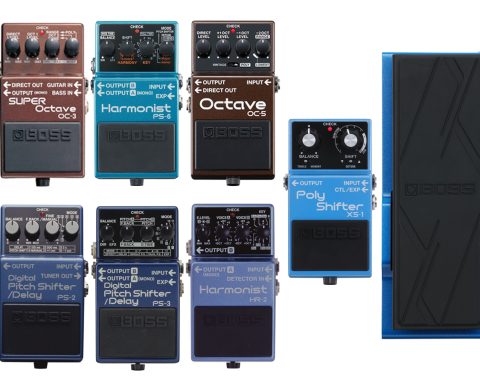The fuzz pedal remains one of the world’s most celebrated, replicated, reinvented, and idolized effects. The original fuzz pedals that paved the way for modern effects fetch eye-watering prices on the used market. Even simple parts, like vintage capacitors, can skyrocket in price due to their demand. More than most effects, the fuzz pedal has legendary incarnations, each coveted for its characteristics and uniqueness. BOSS is part of that vibrant legacy with its FZ series. Here are five ways fuzz can enhance a guitarist’s sound.
A Fuzzy History
In 1962, popular music changed forever with the invention of the first-ever fuzz pedal. More world-changing pedals followed, expanding the audience’s appetite for the famous tone. In 1979, BOSS introduced the first large-format fuzz effects pedal: the DB-5 Driver. However, around that time, fuzz was waning in popularity. Distortion and overdrive pedals like the DS-1 and SD-1 dominated the market throughout the ’80s.
By the early ’90s, grunge saw a resurgence in the popularity of fuzz pedals. In 1993, BOSS created their first compact stompbox fuzz pedal, the FZ-2 Hyper Fuzz. BOSS continued the trend in 1997 with the FZ-3 Fuzz, a pedal paying homage to some of the great fuzz tones of the ’60s.
How Fuzz Works
Despite the many fuzz types, it remains immediately identifiable, unique from traditional amp-like drives. Overdrive and distortion emulate the sound of a valve amplifier pushed beyond its limits, causing the circuit to clip and create that familiar breakup. Fuzz takes this a step further. The effect drives the signal beyond the transistor’s capabilities, so it clips to become almost a square rather than a sine wave. That clipping alongside the natural compression gives us that familiarly aggressive tone.
"Fuzz drives the signal beyond the transistor’s capabilities so that it clips to become almost a square rather than a sine wave."
Setup Configurations
Fuzz is the trickiest pedal to place in the effects chain. It’s technically part of the overdrive/distortion family. As a result, it needs to go early in the chain, before any modulation, and before delays and reverbs. Still, analog fuzz can have some oddities. They are commonly sensitive to input impedance.
To that end, placing anything buffered ahead of the fuzz pedal can cause interference in how the fuzz pedal reacts. This means many vintage analog fuzz pedals must be first in the signal chain. Fortunately, this isn’t the case for digital fuzz pedals, like the FZ-5, or unique analog fuzz pedals, like the FZ-1W. These feature a cleverly designed circuit to handle impedance issues.
FIVE FUZZ PEDAL USES
Big Riffs
Fuzz can be a massive effect. The extreme saturation level from such heavy clipping creates all sorts of wonderfully complex harmonics. Still, those harmonics can be dissonant, unwanted, and hard to control without sacrificing the desired tone.
Listen to some trailblazing tracks that first used fuzz and made it famous. These include The Rolling Stones’ “(I Can’t Get No) Satisfaction” or Jimi Hendrix’s “Foxy Lady.” The common theme of these songs’ lead lines is they’re simple and minimal, with mostly single notes instead of chords.
The simplicity of these riffs allows the fuzz pedal to perform at its best. Fuzz makes a simple note progression stand out and sound massive without the need for overcomplication. Remember that when using fuzz, less is often more; let the pedal’s tone do the hard work.
"Fuzz makes a simple note progression stand out and sound massive without the need for overcomplication."
Starved Fuzz
One of the most legendary, unusual, and fun fuzz tones seems counterintuitive to creating a good guitar tone. Starved fuzz borders on sounding like a broken pedal. Yet that brittle, bee-in-a-box tone is precisely the sound that legions of guitarists have used to add a twist to their guitar tone for decades.
There are many ways to achieve such a tone. Traditionally one could power the pedal with a battery almost out of juice, a method Annie Clark of St. Vincent favors. Conveniently, many fuzz pedals can achieve this effect by rolling off the gain and dialing the tone control fully clockwise. This setting provides the most treble and the least bass. The FZ-5’s M setting is an excellent example of this type of fuzz. Use it for piercing, metallic-sounding fuzz tones that could cut a lemon in half.
Octave Fuzz
Octave fuzz is a glorious thing. Popularized by Jimi Hendrix, it boasts all the glitch and saturation of fuzz with a subtle +1 octave added to the mix. The result is a gnarly, piercing, aggressive-sounding fuzz. It excels for solos and lead lines high on the fretboard.
The BOSS FZ-5 includes a great-sounding octave fuzz mode inspired by late ’60s tones. If traditional fuzz is the perfect pedal for big riffs, then octave fuzz is ideal for screaming guitar solos. Push the fuzz level on the O setting of a FZ-5 to channel your inner Jimi.
"Octave fuzz is a glorious thing. Popularized by Jimi Hendrix, it boasts all the glitch and saturation of fuzz with a subtle +1 octave added to the mix."
Gated Modern Fuzz
Traditional fuzzes have always been a contentious effect. Tonally, they’re unique, aggressive, and steeped in legacy. However, the natural scooped tone can get lost when it comes to a fuzz part in a mix with other musicians and instruments. As fuzz evolved, pedal builders have sought to rectify this issue. The result is a modern fuzz tone, much more mid-focussed with a gated quality due to its enhanced gain stage.
Pedals like the FZ-2 Hyper Fuzz have an active two-band EQ, unusual for analog fuzz pedals. This feature allows players to boost the frequencies lost by the pedal’s massive saturation. The BOSS FZ-1W also includes a modern mode, which is more mid-focused and has a much higher gain threshold. When used to play chords, these fuzz pedals can deliver huge, punishing walls of sound. They maintain clarity and articulation when in a mix with other instruments.
Bass Fuzz
Fuzz isn’t just for guitarists. It can be easy to overlook fuzz for bass. Often a little overpowering, the approach distorts the low end and clips fundamental bass frequencies. However, fuzz can be highly effective for bass players. From Geezer Butler’s fuzz wah tone on Black Sabbath’s “N.I.B” to Chris Wolstenholme’s legendary line on Muse’s “Hysteria,” the trick is tailoring the bass part to the pedal.
"Fuzz can be highly effective for bass players. The approach distorts the low end and clips fundamental bass frequencies."
Many Flavors of Fuzz
Few effects types can claim the fuzz pedal’s prestige, hype, and collectability. It is truly one of the original guitar effects, and with so many different flavors, it can be a minefield for the uninitiated. Still, it’s the most fun a guitarist can have with an effects pedal. The great thing about fuzz is how much better it gets when paired with another effect type.






